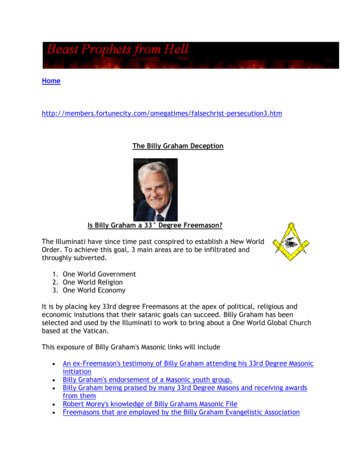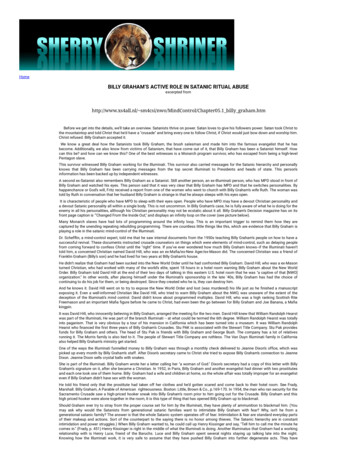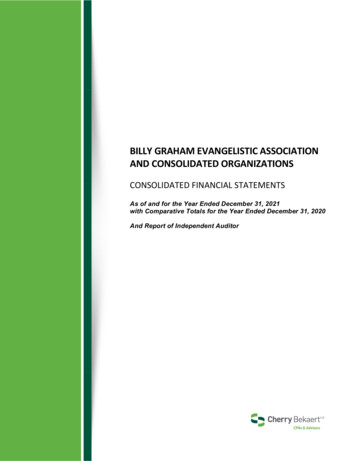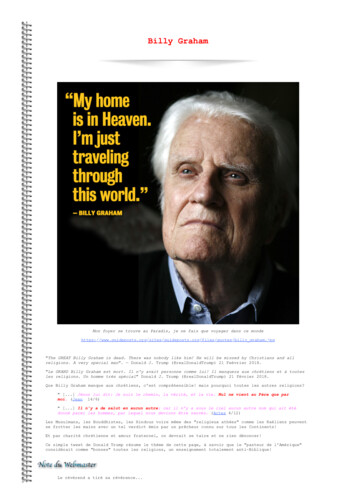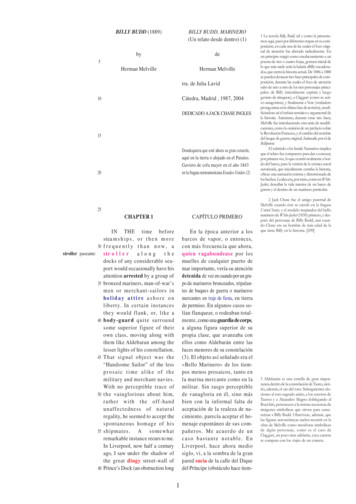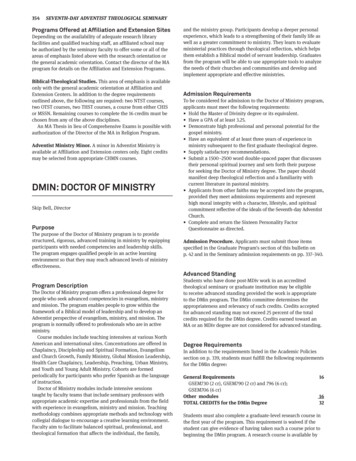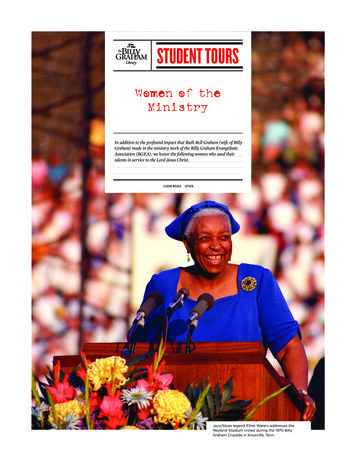
Transcription
Women of theMinistryIn addition to the profound impact that Ruth Bell Graham (wife of BillyGraham) made in the ministry work of the Billy Graham EvangelisticAssociation (BGEA), we honor the following women who used theirtalents in service to the Lord Jesus Christ. 2018 BGEA07129Jazz/blues legend Ethel Waters addresses theNeyland Stadium crowd during the 1970 BillyGraham Crusade in Knoxville, Tenn.
Women of the MinistryGRADE LEVEL9th–12th“Billie Barrows at the piano worked as hard as any of us, and Lorin Whitney tirelessly played the organ. Ruth herself stayed up longhours each night counseling people. None of us would leave the little counseling tent until every person had been personally talked to.”—Dr. Billy Graham, Just As I Am, p. 156OBJECTIVESStudents will be able to: I dentify the varying rolesof women in the formationand success of the BillyGraham EvangelisticAssociation. iscuss the uniqueDcontributions of women tothe ministry.NORTH CAROLINASTANDARD COURSE OFSTUDY, SOCIAL STUDIES12.C.1: Evaluate the challengesof forming an identity in adiverse society founded onfreedom and equality.12.C.2: Understand howsocialization regulatesindividual behavior.Pre-Visit Activities: R ead and review the attached information with students, and discuss the followingquestions: Describe the career path of Mildred Dienert, Billie Barrows, Ethel Waters, andAileen Coleman. In what ways were their areas of service similar? How didtheir roles differ? What hardships did each woman face through her ministry? How do you think each of these women impacted BGEA? Watch Ethel Waters sing: “Where Jesus Is, Tis Heaven”: www.youtube.com/watch?v kJ6e75rV nQ “His Eye is on the Sparrow”: www.youtube.com/watch?v QbeNSatFFoAdditional Optional Reading: His Eye is on the Sparrow by Ethel WatersTo Me, It’s Wonderful by Ethel WatersThe Desert Rat by Annette AdamsRebel With A Cause by Franklin Graham, especially chapters 6 and 7Visit to the Library:NATIONAL CURRICULUMSTANDARDS FOR SOCIALSTUDIES One Two Four Five S tudents will walk through The Journey of Faith tour with an assigned guide. Questions andthemes to consider include: hat evidence do you see of the contributions of these women to the Billy Graham WEvangelistic Association? hich piece of memorabilia related to one or more of these women stands out to you Wmost? Why?Post-Visit Activities: Select from one of the following: With a partner, imagine you are a reporter interviewing one of the women profiledin this study. Write a script of your questions and the responses you believe shewould have given. After completing your script, either perform it live or film itbeing performed. Write an essay detailing the significance of the contributions of each of the womenoutlined in this study. In your essay, include your definition of success and provideexamples of how these women compare to that definition. Read the post-visit overview of additional women who have had an impact on Billy Grahamand the ministry and do the following: Watch “The Making of The Hiding Place”: www.youtube.com/watch?v B3DPRiDXvcI Watch Joni movie trailer: billygraham.org/video/joni/ Listen to GPS: God. People. Stories. podcast – “Broken Body, Grateful Heart: JoniEareckson Tada”.1 of 9 2018 BGEA07129
Women of the Ministry Answer the following questions:W hat impact do you think that prayer warriors like Millie Dienert and PearlGoode had on the ministry of Billy Graham?World Wide Pictures helped to bring to light strong women of faith whoovercame hardships. In what way did these women rely on their faith throughtheir hardships? Did they ever struggle with their faith? 2 of 9 2018 BGEA07129
Women of the MinistryNOTES“Corrie ten Boom . is one of the great Christian heroines of the century. We met her in Switzerland, and her story made such animpression on Ruth that she recommended it to writers John and Elizabeth Sherrill. They jumped at it; and the book and film thatfollowed brought home the horror of those days and the triumph of Christ’s love in the midst of virulent hatred.”—Billy Graham, Just As I Am, p. 434Pre-Visit Reading: OverviewEthel Waters:Ethel Waters was born Oct. 31, 1896, in Chester, Pa. She had a very difficultchildhood and later said, “I never was a child. I never was cuddled, or liked, orunderstood by my family.”Despite the obstacles she faced early in life, Ethel began her singing career at just 17. She wenton to become a renowned singer, actress, and author. In 1933, she became the first AfricanAmerican to receive equal billing status on Broadway—and years later, the first black womanto star in her own television show. Ethel’s vocalist contributions would later be recognizedwhen three of her songs were inducted into the Grammy Hall of Fame. Ethel Waters wasinducted into the Gospel Music Hall of Fame in 1983 and to the Christian Music Hall of Famein 2007.Ethel’s life changed completely when she rededicated her life to Jesus Christ during the BillyGraham Crusade at Madison Square Garden in New York City in 1957. After that, she joinedthe Billy Graham Crusade team and was a featured soloist at Crusades for almost 20 years. In1958, Ethel starred in The Heart is a Rebel, a film of Billy Graham’s production ministry, WorldWide Pictures. Ethel was known especially for her beautiful rendition of “His Eye is on theSparrow,” which was her signature song and the title of her autobiography. She made her finalappearance at the 1976 Billy Graham Crusade in San Diego.“Ethel Waters was one of the most unforgettable characters I ever knew,” Billy Graham shared.“She was a superstar not only on stage and screen, but in her personal religious faith.” She diedon Sept. 1, 1977.Wilma Irene “Billie” Barrows:Billie Barrows was born in 1925 in Macomb, Ill. She was an accomplishedmusician and received a Bachelor of Arts in Sacred Music. She married hercollege sweetheart, Cliff Barrows, the Crusade choir director and board memberof the Billy Graham Evangelistic Association. She first met Billy Graham in 1945 while onher honeymoon and joined his Crusade team shortly thereafter as the pianist and organist,traveling with the organization around the U.S., England, Ireland, Wales, and Scotland forfive years. In 1950, she took a break from traveling to focus on raising her five children. Billiepassed away from cancer in 1994 and is laid to rest in the Memorial Prayer Garden at the BillyGraham Library.3 of 9 2018 BGEA07129
Women of the MinistryNOTESMildred “Millie” Dienert:Mildred “Millie” Dienert was born on Sept. 3, 1917, in Blue Bell, Pa. Her father was atraveling minister, so she spent much of her childhood with her grandparents whileher parents shared the Gospel across the country. She often felt lonely and blamedGod for keeping her away from her parents for extended periods of time—but when she was17, she was the only survivor of a car accident and rededicated her life to the Lord.Millie went on to marry Fred Dienert, whose advertising company handled Billy Graham’sradio and TV ministries. In the mid-1960s, Billy Graham asked Millie to go to London andorganize a series of prayer groups to pray for the success of the Crusade in Great Britain.Millie’s efforts there—and prior to future Crusades—led to her being widely known as theFirst Lady of Prayer as well as being honored as the Churchwoman of the Year in 1990. In herlater years, Millie also became a very popular speaker in her hometown, with over 500 peopleattending her weekly Bible study. Millie died on Aug. 24, 2015, at the age of 97.Aileen Coleman:Aileen Coleman was born in 1930 in Bundaberg, Queensland, Australia. She lovedswimming and had an adventurous spirit even as a child. One night while incollege, Aileen went to an evangelistic tent meeting on a dare—and surrendered herlife to Jesus Christ that night.After college, she went to nursing school and then Bible college. While researching a paper onmission work in the Middle East, she felt God calling her to become a missionary nurse in theregion, and traveled there in 1955. During the course of her ministry, she has nursed countlessBedouin people suffering tuberculosis and other illnesses, and she has raised over ninechildren who were either abandoned by their parents or whose mother died. The Bedouinslovingly call her “A’Raiisa,” which means “the leader.”In the summer of 1971, Franklin Graham met Aileen while on a trip to Mafraq, Jordan, andwas inspired by her work with the people there. Her mission work has been honored byQueen Noor of Jordan as well as Queen Elizabeth II of England, who granted her the titleof Dame Aileen Coleman. Aileen continues to minister to the Bedouin people and considersJordan to be her home.4 of 9 2018 BGEA07129
Women of the MinistryMillie Dienert leads a women’s prayer rally priorto the 1969 Billy Graham Crusade in Melbourne,Australia.Pre-Visit Reading: Discover more about the impact of MillieDienert’s work in this Decision magazine article.“A Passion for Souls, A Passion for Prayer”, by Cliff Barrowsfrom Decision magazine, April 2005:Cliff Barrows, a longtime friend and associate of Billy Graham, as well as music and program directorat his Crusades, has worked beside Mr. Graham (affectionately known to him as “Bill”) for nearly 60years. He has also been a “prayer historian” of this foundational element of BGEA’s ministry throughthe decades.Prayer has been the heartbeat of our mission.“The three most important things you can do,” Billy Graham says, “are to pray, pray, pray!”Bill and I spent six months in the United Kingdom in 1946 and 1947 and, in Wales, we heardaccounts of the Welsh Revival. Those accounts touched Bill’s heart. He was moved to challengepeople to pray for revival.Bill had a passion to fulfill his calling as an evangelist and to pray that God would lead in everystep in fulfilling our mission. That drew us together and cemented our relationship over sixdecades. Our praying together brought us into a unique covenant relationship—much likeJonathan and David of the Old Testament—that God has preserved and kept to this day.One of our very first U.S. Crusade meetings was in 1947 in Charlotte, N.C., Bill’s hometown.There we began noontime prayer meetings and radio programs. About a month before aCrusade, we would buy time for a morning slot on a local radio station. The Billy Graham PrayerTime Program was the basis of the first “cottage prayer meetings,” during which women whowere gathered in homes would tune into the program.5 of 9 2018 BGEA07129
Women of the MinistryIf a Crusade city wasn’t too large, we tried to have radio-coordinated prayer meetings on everycity block. The program would include music, a brief devotional and prayer requests. I wouldannounce the sermon title for the next night and say, “All over this town people are praying.”The groups would share their prayer requests in their homes and pray.Listeners were encouraged to pray out loud and to use sentence prayers: “You don’t have to beformal in your prayers,” I would say. “You may not be able to pray like your pastor prays, but justtalk to your heavenly Father like I’m talking to you today —or like you would talk to your earthlyfather or your dearest friend. That’s who Jesus is, and He’s concerned about us.”Half-nights of prayer were held at the Crusade’s prayer tent. We would be in those prayertents on our knees in the sawdust until 1 or 2 in the morning. If no prayer tent was available,intercessors would go to a church to pray. That happened in city after city.Back in 1949 a woman named Pearl Goode, who lived in Los Angeles, had prayer seminars inher home with Fuller Seminary students and taught them the ministry of prayer. Unknown tous, she was a prayer warrior for the first LA Crusade and followed us for several years. God laidupon her heart a burden for those Crusade cities. She would make arrangements to stay in anarea home or in a room by herself. She would not attend the Crusade meetings, but she prayedfor Bill especially as he was preaching, that God would anoint him. She made it her ministry tobe on her knees during his preaching and invitation time. She would call out, “Lord, bless Billytonight as he preaches on the cross. Pour out Your Spirit into his heart.”When you have somebody praying, crying out to God like that, it gives you great confidence thatGod is going to honor “the effective, fervent prayer of a righteous person” (Cf. James 5:16). He’spromised to do that. We believe that and encourage people to pray. God honored Pearl’s prayers.Eventually we found out that she was coming, and we made possible her transportation—but forseveral years she scraped up enough money to get to Crusade cities on her own. In those dayswe would have sometimes eight and 10 meetings a year. She would go to as many as she could.Our prayer emphasis increased at the 1949 LA Crusade and even more specifically at theColumbia, S.C., Crusade in 1950. There we started having a prayer chairman for the Crusades.Our Crusade Director, Willis Haymaker, took seriously this prayer concern, and he and Mr.Graham chose as the basis for our prayer emphasis 2 Chronicles 7:14: “If my people, which arecalled by my name, shall humble themselves, and pray, and seek my face, and turn from their wickedways; then will I hear from heaven, and will forgive their sin, and will heal their land” (KJV). We havecontinued to use this verse to this day.Also, our associate Grady Wilson led a prayer chain at Crusade meetings. He would take a fewminutes each night during the service to establish time periods for people to pray. “How manyof you will take from 10 to 10:30 when you get home tonight?” he would ask. “Raise your hand.”We set up 30-minute segments through the night and people would set their clocks to get up inthe night and pray earnestly for the Crusade.6 of 9 2018 BGEA07129
Women of the MinistryA short time later we began using the Operation Andrew cards, on which Christians listedthe people they would pray for and invite to the Crusade. In the mid-1980s, the prayer tripletprogram was launched. People would covenant with two others to spend time praying togetherduring the day—often businesspeople would do it at noontime. Each person would have threepeople for whom to pray specifically, and he or she would share the names so that each wouldhave nine names on his or her prayer list. This got people praying fervently and specifically.Millie Dienert came on the scene about 1950. Her husband, Fred, and his partner, WalterBennett, had contacts with the ABC networks. They urged Bill to go on the radio with The Hourof Decision.Millie organized worldwide prayer for all of BGEA’s Conferences. We had the Berlin Congress(1966), the Lausanne Congress (1974) and the Amsterdam Conferences (1983, 1986, 2000)—andshe was the one who coordinated prayer groups around the world.In each country she had prayer chairmen who had contacts within the country. She traveledacross the United States to speak at prayer rallies—and she did it at her own expense.BGEA has used various prayer reminders through the years. The 1957 New York Crusade usedstickers that read “Pray for New York.” People could put them on the old dial telephones andwould be reminded to pray whenever they went to the phone. Those stickers were sent out bythe thousand.We’ve also used small, colored “prayer dots,” which people could place in the center of theirwatches. People were reminded wherever they were: “Pray on the spot when you see the dot.” Ihad a blue dot stuck on the center of my watch. Sometimes it was just a flash prayer, but it was aGod-consciousness: “Lord, we need You to move in this situation.”Prayer reminders were sent out with messages like “Prayer changes things” and “Prayer changespeople.” Every avenue we could think of to encourage people to pray was exhausted.Pray, pray, pray. That is the greatest need of our ministry still today. It’s not organization or greatcorporate structures or design strategy. All of that is good, but we’ve got to humble ourselvesbefore God and put the emphasis on prayer. Any ministry or organization in Christian work isonly as powerful as the prayer life of its leaders.“The effective, fervent prayer of a righteous man avails much” (James 5:16, NKJV). Don’t give up.Hang on. George Müller, the great prayer saint of the 19th century from Bristol, England, prayedfor some 50 years for a friend who came to Christ after Müller passed away. “More things arewrought by prayer than this world dreams of,” wrote Alfred Lord Tennyson.Someday we’ll know the answers to our prayers.7 of 9 2018 BGEA07129
Women of the MinistryPost-Visit Reading: Overview of Additional Women ContributorsHenrietta Mears:Henrietta Mears was born on Oct. 23, 1890, the seventh child of a banker and a Baptistlaywoman. Henrietta’s father owned more than 20 banks, but the family wealth wassignificantly impacted during the Panic of 1893. Henrietta loved learning and graduatedfrom college at the University of Minnesota before becoming a chemistry teacher in ruralMinnesota.In 1915, she moved back to Minneapolis to live with her sister, and it was there that her churchencouraged her to apply educational principles to Sunday school lessons. In 1927, after teachingSunday school for over a decade, Henrietta visited Hollywood, Calif., where she met StuartMacLennan, pastor of First Presbyterian Church of Hollywood, which had a Sunday school of450 students. While visiting California, Henrietta felt God’s call to enter full-time ministry, andshe became the Director of Christian Education at MacLennan’s church. Henrietta grew theSunday school attendance to 6,500 students enrolled during her tenure. She was well-respectedand had a significant impact on evangelists such as Billy Graham, Bill Bright (founder of CampusCrusade for Christ), and Louis H. Evans, Jr. (pastor of Bel Air Presbyterian Church, where RonaldReagan attended).Henrietta introduced Billy Graham to many celebrities of the day and was integral in Mr. Graham’sacceptance of the Bible as the inspired Word of God. As Mr. Graham recounts of Miss Mears in hisautobiography, Just as I Am, “Rarely had I witnessed such Christian love and compassion as she hadfor those students. She had faith in the integrity of the Scriptures, and an understanding of Bibletruth as well as modern scholarship. I was desperate for every insight she could give me.”Pearl Goode:Pearl Goode first came to know of Billy Graham and his ministry during the first night ofhis 1949 Crusade in Los Angeles, Calif. At the time, she was a widowed nurse in her 60sand looking for God’s next call on her life. During the Crusade, she joined the volunteerprayer team and spent many nights in a smaller tent outside the larger Crusade tent in prayer for theCrusade. After that Crusade, Pearl continued to be a prayer warrior for the Crusades, unbeknownstto Billy Graham and his team. She would check in at a motel near the Crusade venue and pray,sometimes all night, for the success of the Crusade. All of this travel was at her own expense, and sheestimated at one time that she had traveled over 48,000 miles by Greyhound bus to support BillyGraham and his ministry in prayer. In an address he gave in 1994, Billy Graham said, “She prayed allnight many nights, and I could sense the presence and power of that prayer. When she died, I felt it.”Corrie ten Boom:Corrie ten Boom was born on April 15, 1892, in Amsterdam, Netherlands, to a workingclass family. Her father was a watchmaker and jeweler, and Corrie eventually became thefirst licensed female watchmaker in Holland. After the Nazis invaded Holland in 1940, theTen Boom family helped Jewish refugees and members of the resistance movement go into hidingthrough the Dutch Underground. Their refuge was known as “De Schuilplaats” or “The Hiding8 of 9 2018 BGEA07129
Women of the MinistryPlace.” On Feb. 28, 1944, a Dutch informant notified the Gestapo of the Ten Boom’s assistanceto the resistance, and the family was arrested and sent to prison. Corrie and her sister Betsieeventually ended up at Ravensbrück concentration camp.Betsie’s health declined significantly at the camp, and she died 15 days before Corrie wasaccidentally released from the camp due to a clerical error. Corrie later learned that all of theother women her age were sent to the gas chambers a week following her release. After the war,Corrie opened a rehabilitation center for survivors of the concentration camps, wrote manybooks, and traveled the world as a public speaker. Her 1971 book, The Hiding Place, was turnedinto the most successful movie—with the same title—produced by the Billy Graham EvangelisticAssociation’s film company, World Wide Pictures. In Billy Graham’s autobiography, Just as I Am,he wrote: “Corrie is one of the great Christian heroines of the century.” Corrie died on her 91stbirthday in 1983 after suffering a series of strokes.Joni Eareckson Tada:Joni (pronounced “Johnny”) Eareckson was born in 1949 in Baltimore, Md. Her fatherwas an alternate for the 1932 Olympics wrestling team, and Joni lived an active life,enjoying activities like horseback riding, tennis, and swimming.In 1967, she suffered a tragic diving accident when she misjudged the shallowness of thewater. As a result, she was left as a quadriplegic, paralyzed from the shoulders down. Duringher rehabilitation, she suffered from depression and suicidal thoughts. In 1976, she pennedher autobiography, which was turned into a film in 1979 by the Billy Graham EvangelisticAssociation’s film company, World Wide Pictures. In 1979, Joni also founded Joni and Friends,an organization to share the Gospel with the disabled. In 1982, she married Ken Tada, a highschool history teacher, and they continue to live in Calabasas, Calif. Today, Joni is a well-knownconference speaker, writer, and painter who inspires countless people with disabilities tocontinue to seek God’s call on their lives.9 of 9 2018 BGEA07129
attending her weekly Bible study. Millie died on Aug. 24, 2015, at the age of 97. Aileen Coleman: Aileen Coleman was born in 1930 in Bundaberg, Queensland, Australia. She loved swimming and had an adventurous spirit even as a child. One night while in college, Aileen went to an evangelistic tent meeting on a dare—and surrendered her


